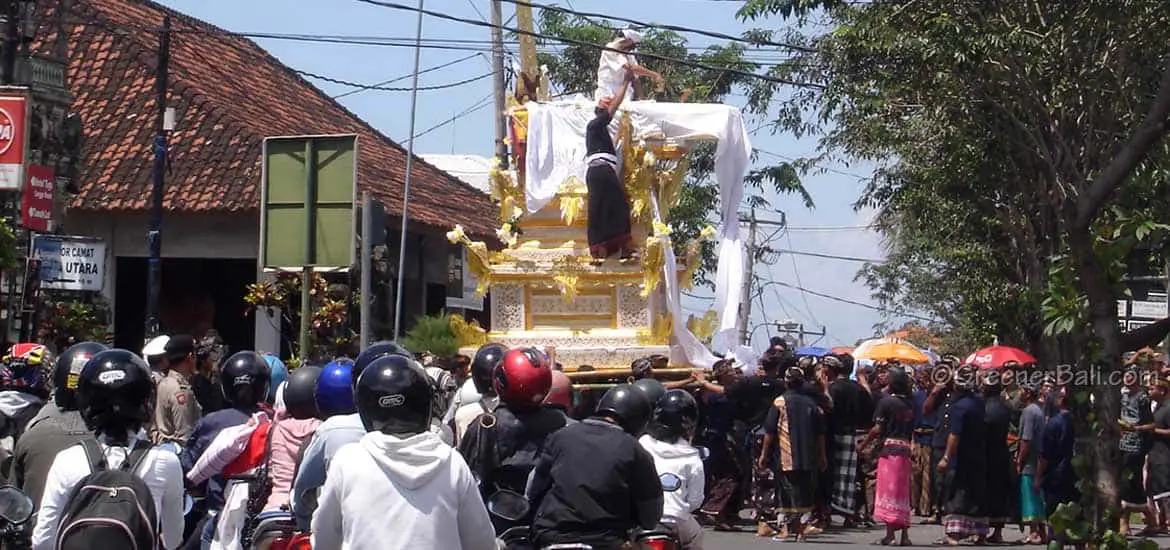Bali Ceremonies are an addition to festivals that are held based on the Hindu Saka calendar and the complicated Pawukon Calendar.
While national holidays, Nyepi day and temple ceremonies are of great importance, each individual life on Bali must undergo several important ceremonies in order to enter, live and leave this world.
The first ceremony is held even before the child is born while the last takes place when the aches of the deceased are scattered into the sea.
All these ceremonies are aimed at one purpose: protection by gods and protection from evil.
The most important Bali life-cycle ceremonies and rituals are
- Pre-birth until losing one’s milk teeth
- Tooth filling and Marriage
- Cremation
From pre-birth till losing one’s milk teeth
The first ceremony of a Balinese takes place before he or she is even born. In the 6th month of the pregnancy, a ceremony with offerings is conducted (pegedong-pegedong) to ensure the well being and health of the baby.
Once the baby is born the afterbirth is to be placed in a coconut which is wrapped in a white cloth and finally buried near the entrance of the parent’s household.
For a short period of time, appropriate ceremonies are conducted regularly on this spot.
Between the 12th and 42nd days of the child’s birth, the mother and baby are considered unclean. Therefore a series of ceremonies take place in which both are purified in order to participate in festivals and religious events.
During this time the god Sanghyang Pance Kumara is also asked to watch over the child and to protect it.
The 105th day is one of the important days for the child as only then will it be given a name. Also during this ceremony (Telubulan) the baby is fully welcomed into the family.
On the first birthday (Oton), which is according to the Balinese calendar on the 210th day, the baby is allowed to touch the ground for the first time. Because the ground is considered impure, the baby has always been carried around up to this day.
This day is again accompanied by a ceremony which is pretty big and takes place at the ancestral temple where families and the community gather to celebrate.
The next ceremony in life takes place as soon as the child loses his/her milk teeth (Maketus).
During this ceremony, the responsibilities of Sanghyang Pance Kumara, the God who has protected the child since birth are withdrawn. From then on the responsibilities rest on the families’ ancestors.
Tooth Filing and Marriage
The festivals and life-cycle ceremonies stop for a while until a Balinese boy or girl reaches the age of adolescence. In this period of life, the important and painful tooth-filing ceremony (Mapandes) takes place, preferably before marriage.
By filing away the sharp points of the canine teeth the Balinese believe that human behavior such as lust, greed, anger, drunkenness, jealousy, etc. is removed from that specific person.
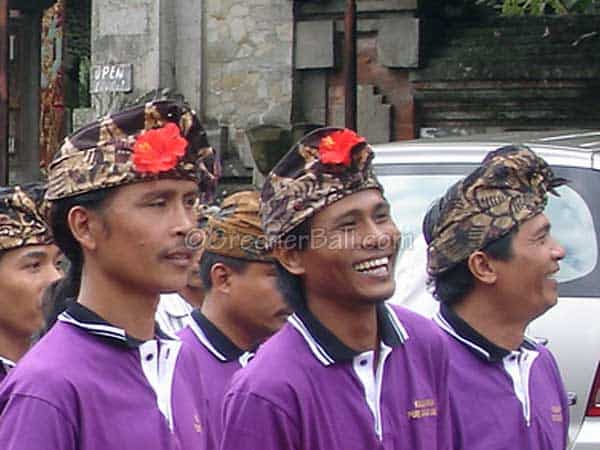
Several young Balinese can undergo this ceremony at the same time and it is often accompanied by a lot of guests, music and many offerings. It is one of the most important ceremonies as it ensures a good reincarnation.
Whether or not you believe this reason for tooth filing, I must say that the Balinese have one of the most dashing smiles I have seen.
The next of the many ceremonies in life is marriage. Traditionally the Balinese still marry at a young age compared to people on other continents.
While they are not pre-arranged the existing Balinese caste system still has some influence on choosing the right bride or groom.
It’s possible if the bride and groom choose to celebrate this occasion with their parents and other members of both families. This means grand ceremonies that can cost a fortune.
Or…
They can elope. Eloping is more of a show than the real thing because the parents just pretend not to know.
The Balinese way of eloping is that the man and woman run off together and get married the next day during a private ceremony.
When they return the parents continue their ‘role in this play’ and act if they are outraged.
Ceremonies that take place soon afterward are often without the bride’s parents as they still ‘disagree’ about the whole thing.
But of course, all ends well as after 3 days when the parents meet and another ceremony takes place (Ketipat Bantal) and the parents reconcile.
As you can imagine it costs less compared to the first option. So couples often choose to elope. Understandably when you realize that the most important and final event of all Balinese ceremonies in life is the most expensive. This ceremony is the Balinese cremation or ngaben in Balinese.
Ngaben, The Balinese Cremation
The Ngaben is the last and most important ceremony of every Balinese life. It’s the Balinese word for the cremation of the dead, in which the soul is released entirely from the body to ascend to heaven and to be reincarnated.
The cremation is a big happening in Bali, especially a royal cremation such as in Ubud in July 2008.
But before a cremation can actually take place, there are many complicated rituals, ceremonies, and preparations before and after the cremation.
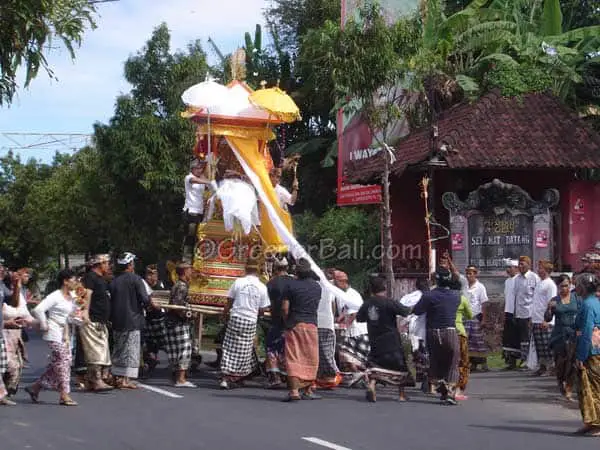
The three major events which take place before the soul of the deceased is fully released are:
- The Funeral: here the prethiwi (solids) are placed into the earth by burial
- The Cremation: the teja (radiance) is released by burning with fire
- The purification of the soul: the apah (liquids) is dispersed by throwing the ashes into the water
Before the influence of the Majapahit, which spread the Hindu religion throughout Bali, the Balinese guided the soul of the deceased in a more simple way. The deceased was taken into the forest. Here the high humidity and the animals would break the body down quickly. Through this way, the soul would be released from the body.
Today this burial method only takes place in the Bali Aga villages. These villages such as Tenganan and Trunyan who have never been influenced by the Majapahit before.
The Funeral
In Bali, a funeral takes place shortly after a person dies. Unlike the Hindu in India where the deceased is cremated immediately.
The deceased is buried at the Pura Dalem, the temple complex facing the sea. The Pura Dalem is also often referred to as ‘the temple of the dead’.
The length of the period between the funeral and the Ngaben depends entirely on the financial position of the family. Sometimes it even takes years. Only the rich are cremated shortly after they have passed away on an auspicious day.
Priests, who always belong to the highest caste, are never buried. They are kept in their own house until the family has gathered sufficient money for the ngaben.
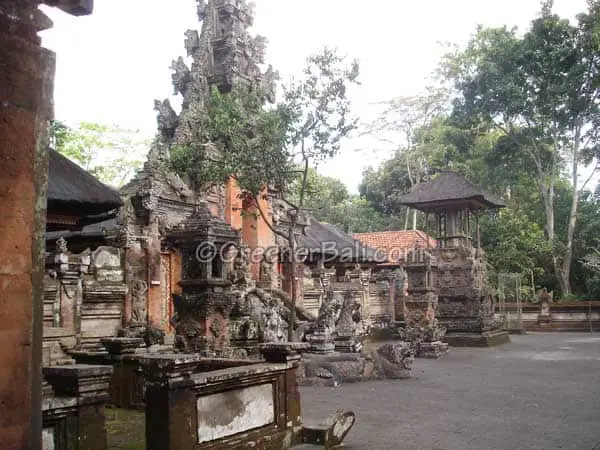
Before the funeral, the body of the deceased is purified according to several ceremonies and then buried. The family can place daily food offerings on a small shrine that is built next to the grave.
The Balinese always place small coconut-leaves at the head and the feet of the grave. This enables the demon of the deceased to find its way back after wandering at night. If there are no leaves at the grave, then the demon will wander forever. The Balinese believe this will have a negative impact on the village and family.
The whole period before the actual Ngaben is considered as a very sad time. During this period the soul is not able the reach heaven yet.
Only when there is enough funding, all the preparations have been made and the appropriate date has been determined by the priests, will the soul of the deceased be released through the Ngaben.
The Cremation
Every Balinese family has the responsibility to ensure that a proper cremation takes place if a family member dies. If this does not happen this will have severe consequences for the deceased and his/her family. Families who can’t afford a cremation often await the Ngaben of an important or royal person.
The preparations for these people are always the best ones you can have. The best priest is called upon, the holiest water is used and the appropriate date is chosen for the cremation.
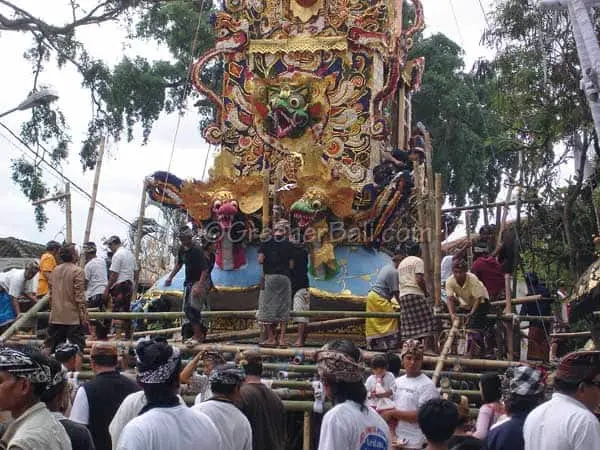
With everything perfectly planned and set for the big cremation ceremony, other bodies will be cremated too so they can profit from the ideal setting in which the cremation will take place.
The families of the deceased will then know for sure that the soul will be guided to heaven under the best circumstances. It is not uncommon to have a mass cremation of 100 people on the same day as the ultimate royal cremation when money does not play an issue…
Unlike the funeral, the Ngaben is a joyful occasion as the soul of the deceased is now ready to continue its journey to heaven followed by reincarnation.
Before it takes place, numerous preparations need to be organized. The body will be taken out of its temporary grave at the Pura Dalem and carried to its former house three days before the cremation. During the whole process, complicated rituals follow a specific order.

A day before the cremation one final ceremony is held at the Pura Dalem. This is when everybody is beautifully dressed in traditional Balinese clothing and when the colorful offerings are carried to the temple.
The Funeral Tower
On the actual day, the body is transported to the Pura Dalem in a funeral tower. The tower is made out of wood and bamboo. The village carpenter and carvers create an amazing structure full of bright decorations. The funeral tower can be a couple to 10 meters high.
In the past it was common to see really high towers, however today this is hardly possible since there are too many telephone and electricity cables hanging over the streets.
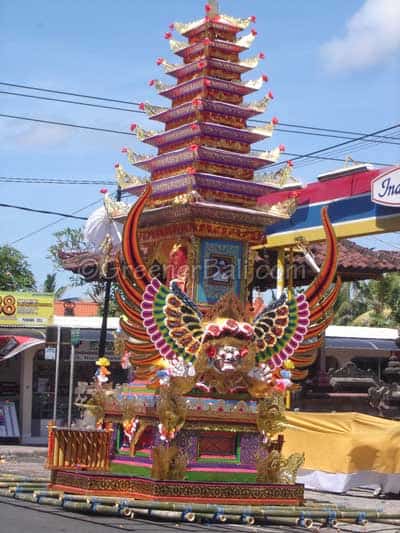
The tower consists of three levels, of which the platform is the highest. Here the body of the deceased is placed while the priests stand next to it and escort it to the Pura Dalem.
The base of the tower is built on bamboo poles which are then placed on the shoulders of a group of men who will carry the tower to the temple.
In order to ensure that the soul of the deceased doesn’t find his/her way back home, the men confuse it by twisting, twirling and making full circles with the tower.
All the men in the village are delighted to take part in this unorganized spectacle. As a spectator, you are just surprised that the tower is still standing in the end.
The Sarcophagus
In front of the procession, another group of men is carrying the sarcophagus, often in the form of a black bull. It is an impressive structure and the decorations are often very grand as a lot of gold is used in the decorations.

The sarcophagus always arrives first at the temple and waits here for the funeral tower to arrive. There is an opening on the back of the bull in which the body will be placed. The final rituals are conducted by the priest who sprinkles holy water on the bull and offerings are placed.
Then the sarcophagus is set on fire in order to purify the deceased. In the past, the widow would be cremated together with her deceased husband as it was her duty to assist him in finding the right way.
But fortunately, when the Dutch ruled over Bali they forbade these practices…
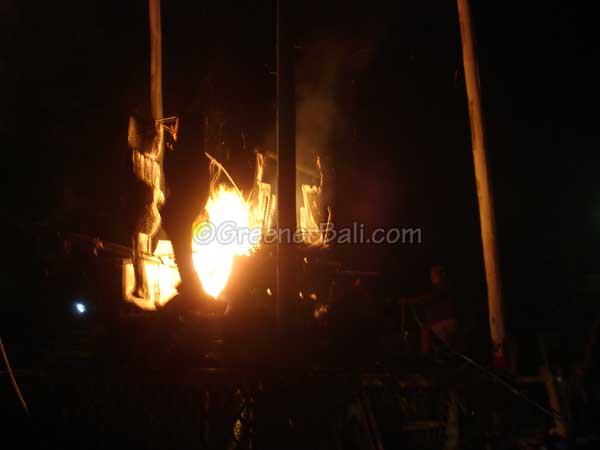
The initial purification of the deceased is a fact only when the whole sarcophagus is turned into ashes. The white ashes of the bones are separated from the others and then places with flowers into yellow and white cloth.
Only then is the soul of the deceased ready for the final ceremony, in which the soul of the deceased is awakened by the priest one final time.
The Final Purification
The final ceremony is usually 12 days after the cremation. But because it is another expensive happening, it can take longer before this ceremony actually takes place.
During this ceremony, the remaining ashes that were placed in the white and yellow cloth are transported on a beautiful construction to the sea.
If the sea is too far, then the ashes will be taken to a river which will eventually carry it to sea.
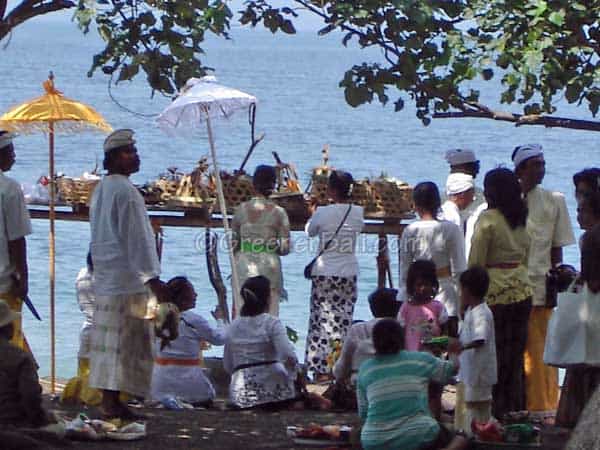
During the Ngaben the soul of the deceased has been purified by fire. The soul then resides in heaven where life is just as in Bali but without diseases and problems.
However, during the last ceremony in which the ashes are placed in the water the soul is released to a higher level. From here the soul can follow the final stage of reincarnation.
The Balinese people believe that the soul will return back as a reincarnation of a new family member, such as the first baby born after this final ritual.

